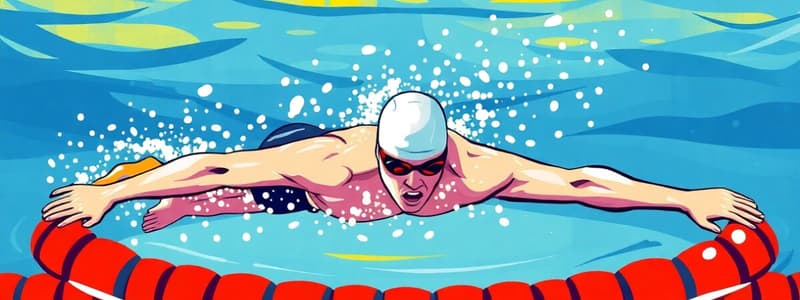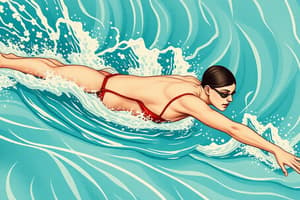Podcast
Questions and Answers
In a medley event, competitors perform backstroke, breast stroke, and ______.
In a medley event, competitors perform backstroke, breast stroke, and ______.
freestyle
A PFD stands for Personal ______ Device.
A PFD stands for Personal ______ Device.
Flotation
The ______ kick is commonly used in side stroke swimming.
The ______ kick is commonly used in side stroke swimming.
Scissors
In synchronized swimming, competitors perform strokes and figures to ______.
In synchronized swimming, competitors perform strokes and figures to ______.
A natatorium is a building where swimming and other sports ______ take place.
A natatorium is a building where swimming and other sports ______ take place.
During the ______ phase, the swimmer's arms are returning for another thrust.
During the ______ phase, the swimmer's arms are returning for another thrust.
SCUBA stands for Self Contained Underwater ______ Apparatus.
SCUBA stands for Self Contained Underwater ______ Apparatus.
The ______ position refers to lying on one's back while swimming.
The ______ position refers to lying on one's back while swimming.
The principle that states an object immersed in a medium is buoyed up by a force equal to the weight of the volume displaced is known as ______.
The principle that states an object immersed in a medium is buoyed up by a force equal to the weight of the volume displaced is known as ______.
The upward force of water on a submerged object is referred to as ______.
The upward force of water on a submerged object is referred to as ______.
The ______ stroke is considered the second fastest stroke in competitive swimming.
The ______ stroke is considered the second fastest stroke in competitive swimming.
In swimming, ______ is the term used for both legs moving up and down alternately.
In swimming, ______ is the term used for both legs moving up and down alternately.
A ______ is a swimming race where each team member swims a leg using any stroke over a prescribed distance.
A ______ is a swimming race where each team member swims a leg using any stroke over a prescribed distance.
The ______ is the edge of the pool at water level.
The ______ is the edge of the pool at water level.
The motion of the legs used in butterfly, where both legs kick together, is known as the ______.
The motion of the legs used in butterfly, where both legs kick together, is known as the ______.
Resistance in the water is termed as ______.
Resistance in the water is termed as ______.
Flashcards
Aquatics
Aquatics
Pertaining to water or activities performed in water.
Buoyancy
Buoyancy
The upward force of water on a submerged object.
Archimedes Principle
Archimedes Principle
An object immersed in a medium is buoyed up by a force equal to the weight of the displaced medium.
Butterfly Stroke
Butterfly Stroke
Signup and view all the flashcards
Flutter Kick
Flutter Kick
Signup and view all the flashcards
Freestyle
Freestyle
Signup and view all the flashcards
Dolphin Kick
Dolphin Kick
Signup and view all the flashcards
Kickboard
Kickboard
Signup and view all the flashcards
Medley, individual
Medley, individual
Signup and view all the flashcards
Medley, relay
Medley, relay
Signup and view all the flashcards
PFD
PFD
Signup and view all the flashcards
Prone float
Prone float
Signup and view all the flashcards
Propulsion
Propulsion
Signup and view all the flashcards
Scissors kick
Scissors kick
Signup and view all the flashcards
Synchronized swimming
Synchronized swimming
Signup and view all the flashcards
Tuck
Tuck
Signup and view all the flashcards
Study Notes
Swimming Terminologies
- Aquatics: Pertaining to water or activities performed in water.
- Archimedes Principle: An object immersed in a medium (usually water, but could be any liquid or gas) is buoyed up by a force equal to the weight of the volume of the medium displaced.
- Buoyancy: The upward force of water on a submerged object.
- Butterfly: A swimming stroke, considered the second fastest, where arms move in a crawl action simultaneously hitting, pulling the water, and legs perform a dolphin kick similar to the flutter kick.
- Catch: The point when the hand starts exerting pressure on the water.
- Dolphin kick: An undulating leg motion used in butterfly when both legs kick together.
- Drag: Resistance in the water.
- Entry: The point where a body part first breaks the surface of the water.
- Float: To be suspended in water.
- Flutter kick: Both legs moving up and down alternately.
- Freestyle: A swimming competition event where swimmers can use any competing stroke.
- Freestyle relay: A swimming race where each team of four swimmers swims a leg, or section, using any stroke in a prescribed distance.
- Glide: A period where the body moves in an extended position as a result of prior propulsion through the water. This is the resting phase of some strokes.
- Gutter: The edge of the pool at water level.
- Heat: A race within an event. When there are more competitors than lanes, participants are divided into groups called heats.
- Kick: To propel the body through the water using legs. Types include dolphin, flutter, scissors, and whip.
- Kickboard: A floating device used to practice leg actions.
- Lane ropes: Ropes or wires, often with plastic discs, that run along the pool to guide swimmers.
- Lane marker: A dark contrasting color placed on the pool floor in the center of each lane.
- Leg: A complete section in a relay race.
- Medley, Individual: A swimming event where competitors perform backstroke, breaststroke, and freestyle/crawl stroke over a set distance.
- Medley, Relay: A swimming event where teams compete against each other and members swim backstroke, breaststroke, butterfly, and freestyle/crawl stroke in sequence.
- Natatorium: A building specifically designed for swimming and other water-based sports.
- PFD (Personal Flotation Device): A device designed to support a person in water, such as a vest or life jacket.
- Pike: A body position with knees straight, hips bent, and back rounded. Arms can be on legs or extended to the side.
- Prone: A swimming position where the swimmer lies on his or her front.
- Prone float: To float facing down with arms and legs extended.
- Propulsion: Movement through water as a result of arm or leg action.
- Pull: An action of arms imparting force on the water toward the body to propel a person through the water.
- Push: Action of the arm or legs that propels a person through the water by imparting force on the water away from the body.
- Recovery phase: Part of a stroke where arms or legs have thrust the body through the water and are returning to the initial position for another thrust.
- Scissors kick: A kick involving bending and extending the legs forward and backward, related to the body, and squeezing for a stretch position used in side stroke.
- SCUBA: Self-Contained Underwater Breathing Apparatus (usually an air tank).
- Supine: A swimming position where the swimmer lies on his or her back.
- Supine float: To float upright. Position and degree of horizontal or vertical positioning depends on body density.
- Synchronized swimming: A form of swimming where competitors perform various strokes and water gymnastic figures to music.
- Touch turn: A racing turn used during breaststroke and butterfly.
- Transition: The period of time a swimmer is under the water during a start or turn.
- Tuck: A body position with bent knees, hips, and chest on knees. Hands hold shinbones. Head tilted forward or backward.
- Tuck float: To float with flexed hips and knees with hands holding shins, head down, and a rounded back bobbing above the surface.
- Tumble turn: A racing turn in front crawl.
- Whip: A recovery or power kick where knees are bent and ankles flexed, toes rotated outward during recovery, then feet and legs press out and down into extension.
Studying That Suits You
Use AI to generate personalized quizzes and flashcards to suit your learning preferences.




